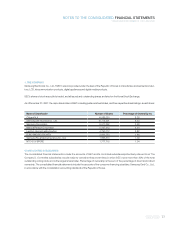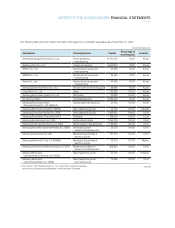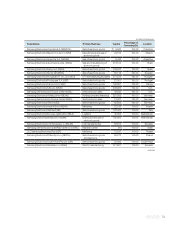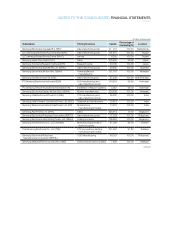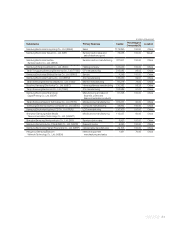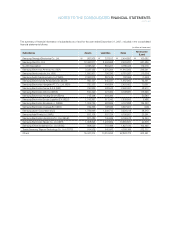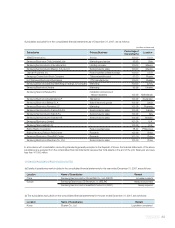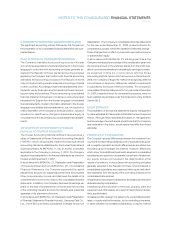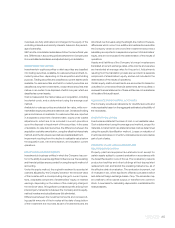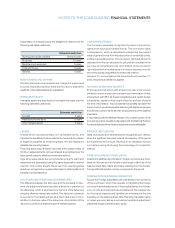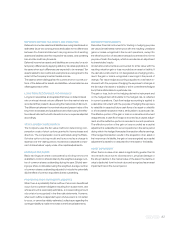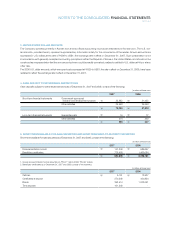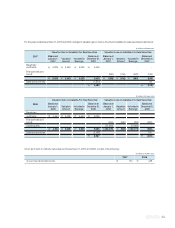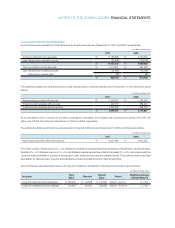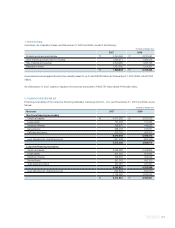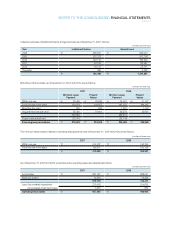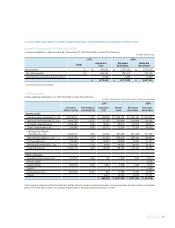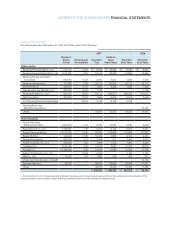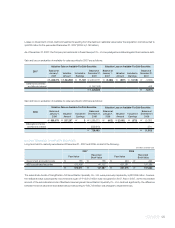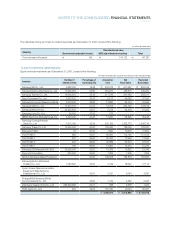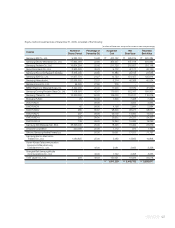Samsung 2007 Annual Report Download - page 89
Download and view the complete annual report
Please find page 89 of the 2007 Samsung annual report below. You can navigate through the pages in the report by either clicking on the pages listed below, or by using the keyword search tool below to find specific information within the annual report.87
DEFERRED INCOME TAX ASSETS AND LIABILITIES
Deferred income tax assets and liabilities are recognized based on
estimated future tax consequences attributable to the differences
between the financial statement carrying amounts of existing
assets and liabilities and their respective tax bases, and operating
loss and tax credit carryforwards.
Deferred income tax assets and liabilities are computed on such
temporary differences by applying statutory tax rates applicable to
the years when such differences are expected to be reversed. Tax
assets related to tax credits and exemptions are recognized to the
extent of the Company’s certain taxable income.
The balance sheet distinguishes the current and non-current por-
tions of the deferred tax assets and liabilities, whose balances are
offset against each other.
LONG-TERM RECEIVABLES AND PAYABLES
Long-term receivables and payables that have no stated interest
rate or whose interest rate are different from the market rate are
recorded at their present values using the market rate of discount.
The difference between the nominal value and present value of the
long-term receivables and payables are amortized using the effec-
tive interest rate method with interest income or expense adjusted
accordingly.
STOCK-BASED COMPENSATION
The Company uses the fair-value method in determining com-
pensation costs of stock options granted to its employees and
directors. The compensation cost is estimated using the Black-
Scholes option-pricing model and is accrued as a charge to
expense over the vesting period, recorded as a separate compo-
nent of shareholders’ equity under other capital adjustments.
EARNINGS PER SHARE
Basic earnings per share is calculated by dividing net income
available to common shareholders by the weighted-average num-
ber of common shares outstanding during the year. Diluted earn-
ings per share is calculated using the weighted-average number
of common shares outstanding adjusted to include the potentially
dilutive effect of common equivalent shares outstanding.
PROVISIONS AND CONTINGENT LIABILITIES
When there is a probability that an outflow of economic benefits will
occur due to a present obligation resulting from a past event, and
whose amount is reasonably estimable, a corresponding amount
of provision is recognized in the financial statements. However,
when such outflow is dependent upon a future event, is not certain
to occur, or cannot be reliably estimated, a disclosure regarding the
contingent liability is made in the notes to the financial statements.
DERIVATIVE INSTRUMENTS
Derivative financial instruments for trading or hedging purpose
are valued at estimated market price with the resulting unrealized
gains or losses recognized in the current operations, except for
the effective portion of derivative transactions entered into for the
purpose of cash-flow hedges, which is recorded as an adjustment
to shareholders’ equity.
All derivative instruments are accounted for at fair value with the
resulting valuation gain or loss recorded as an asset or liability. If
the derivative instrument is not designated as a hedging instru-
ment, the gain or loss is recognized in earnings in the period of
change. Fair value hedge accounting is applied to a derivative in-
strument with the purpose of hedging the exposure to changes in
the fair value of an asset or a liability or a firm commitment (hedged
item) that is attributable to a particular risk.
The gain or loss, both on the hedging derivative instrument and
on the hedged item attributable to the hedged risk, is reflected
in current operations. Cash flow hedge accounting is applied to
a derivative instrument with the purpose of hedging the exposure
to variability in expected future cash flows of an asset or a liability
or a forecasted transaction that is attributable to a particular risk.
The effective portion of the gain or loss on a derivative instrument
designated as a cash flow hedge is recorded as a capital adjust-
ment and the ineffective portion is recorded in current operations.
The effective portion of the gain or loss recorded as a capital
adjustment is reclassified to current operations in the same period
during which the hedged forecasted transaction affects earnings.
If the hedged transaction results in the acquisition of an asset or
the incurrence of a liability, the gain or loss recognized as a capital
adjustment is added to or deducted from the asset or the liability.
ASSET IMPAIRMENT
When the book value of an asset is significantly greater than its
recoverable value due to obsolescence, physical damage or
the abrupt decline in the market value of the asset, the decline in
value is deducted from the book value and recognized as an asset
impairment loss in the current period.


